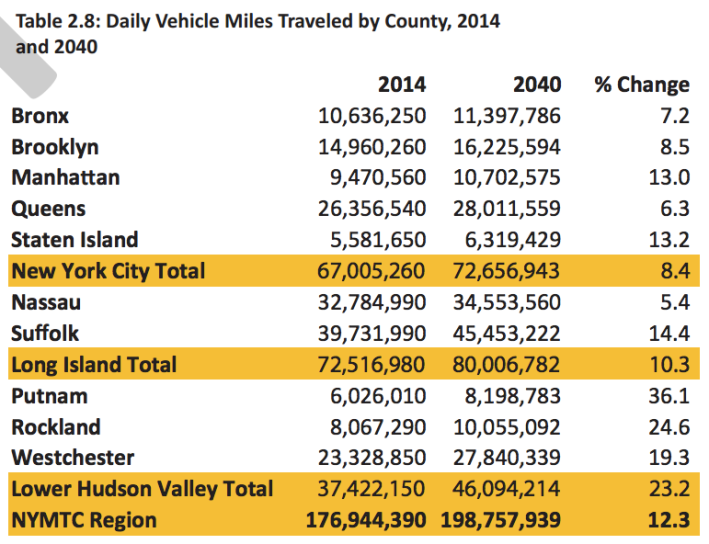
Tomorrow, the New York Metropolitan Transportation Council, the regional planning body that coordinates transportation investments in New York City as well as Nassau, Suffolk, Westchester, Putnam, and Rockland counties, is set to adopt a slate of plans outlining the region's transportation future. But according to the Tri-State Transportation Campaign, the assumptions underlying these plans rely on data that's quickly becoming outdated. TSTC warns that regional planners could be setting the stage for big road projects instead of trying to curb traffic in and around NYC.
NYMTC uses a complex model that crunches numbers on population, employment, transit service, road capacity, and other factors to derive its projections, which it updates every four years. The latest round of projections [PDF] show two encouraging signs: Transit ridership is expected to grow more quickly than driving, and driving is projected to grow more slowly than the population. By 2040, NYMTC projects a 13.4 percent population increase, a 12.3 percent increase in vehicle miles traveled, and a 20 percent jump in the number of transit trips.
This is a change from the previous round of projections, which anticipated that increases in driving would outpace population growth. NYMTC projected in 2009 [PDF] that the regional population would grow 15 percent by 2035, while VMT was expected to grow slightly faster, at a 16 percent clip.
"The demographics are showing that people are driving less," Tri-State Transportation Campaign's Ryan Lynch said. "The report to a certain degree recognizes that, but I think the plan could be a little more aggressive."
A series of reports, most recently from U.S. PIRG, have called attention to the fact that the average American has been driving less and less each year since 2005. In New York state, driving per person has fallen 10.4 percent from its 2006 peak, a far bigger drop than NYMTC projects for the coming decades.
While acknowledging that its modest projected reduction in per capita driving "may indicate a correlation with national VMT trends," NYMTC did not use the opportunity to publicly reassess its models. In fact, the agency discounted the stats showing a drop in VMT, saying that "the effects of the recession... and historically high gas prices should be taken into account," even though compelling evidence indicates that the drop in driving is not strongly linked to the economic downturn.
In July, Tri-State submitted its comments on the plan [PDF], saying that NYMTC's VMT projections were too high and its transit projections too low in the face of new trends documented across the nation over the past decade.
"The rate of decrease in VMT per capita and the rate of increase in transit trips per capita are not in the same order of magnitude as the national trends," NYMTC responded [PDF], because New York is "a mature metropolitan area where transit has been a viable option for over a century."
Lynch said that just because New York already has a strong transit network doesn't mean it can't continue to shift trips away from automobiles. "There is ample room for growth, particularly as transit-oriented development takes hold on Long Island and the Hudson Valley," he said, citing East Side Access, the LIRR third track project, and potential bus rapid transit routes.
Tri-State also asked NYMTC to include VMT reduction as a specific goal in its plans. The council rejected this request, saying that the plan already called for expanded road pricing and demand management programs to reduce congestion and pollution. "A logical result of these outcomes and actions would be a reduction in the growth of VMT," NYMTC said.
"They could argue that widening a road reduces congestion," Lynch said. "It's important for them to explicitly say that a goal is to reduce the number of vehicle miles traveled."





